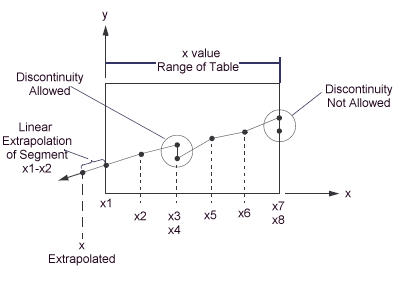TABLEM2 |

|

|

|

|
|
TABLEM2 |

|

|

|

|
Bulk Data Entry
TABLEM2 – Material Property Table, Form 2
Description
Defines a tabular function for use in generating temperature-dependent material properties. Also contains parametric data for use with the table.
Format
(1) |
(2) |
(3) |
(4) |
(5) |
(6) |
(7) |
(8) |
(9) |
(10) |
TABLEM2 |
TID |
X1 |
|
FLAT |
|
|
|
|
|
|
x1 |
y1 |
x2 |
y2 |
x3 |
y3 |
-etc.- |
|
|
|
Field |
Contents |
TID |
Table identification number. (Integer > 0) |
X1 |
Table parameter. (Real) |
FLAT |
Specifies the handling method for y-values outside the specified range of x-values in the table. = 0: If an x-value input is outside the range of x-values specified on the Table, the corresponding y-value look up is performed using linear extrapolation from the two start or two end points. = 1: If an x-value input is outside the range of x-values specified on the Table, the corresponding y-value is equal to the start or end point, respectively. Default = 0 (0 or 1) |
xi, yi |
Tabular values. Any xi-yi pair may be ignored by placing 'SKIP' in either of the two fields. (Real) |
Comments
| 1. | xi must be in either ascending or descending order, but not both. |
| 2. | Discontinuities may be specified between any two points except the two starting points or two end points. For example, in the figure below, discontinuities are allowed only between points x2 through x7. Also, if y is evaluated at a discontinuity, then the average value of y is used. In the figure, the value of y at x = x3 is y = (y3+y4)/2. |
| 3. | At least one continuation entry must be specified. |
| 4. | The end of the table is indicated by the existence of "ENDT" in either of the two fields following the last entry. An error is detected if any continuations follow the entry containing the end-of-table flag "ENDT". |
| 5. | For FLAT=0 (default), TABLEM2 uses the algorithm: |
y= z [yT (x – X1)]
Where, x is input to the table, y is returned, and z is supplied from the MATi entry. The table look-up is performed using linear interpolation within the table and linear extrapolation outside the table using the two start or end points (see figure). No warning messages are issued if table data is input incorrectly.

Example of table extrapolation and discontinuity
For FLAT=1, the same algorithm as FLAT=0 is used, except that values outside the range are not extrapolated. The corresponding start or end point y-values are used for all y-values outside the range.
| 6. | This card is represented as a loadcollector in HyperMesh. |
See Also: